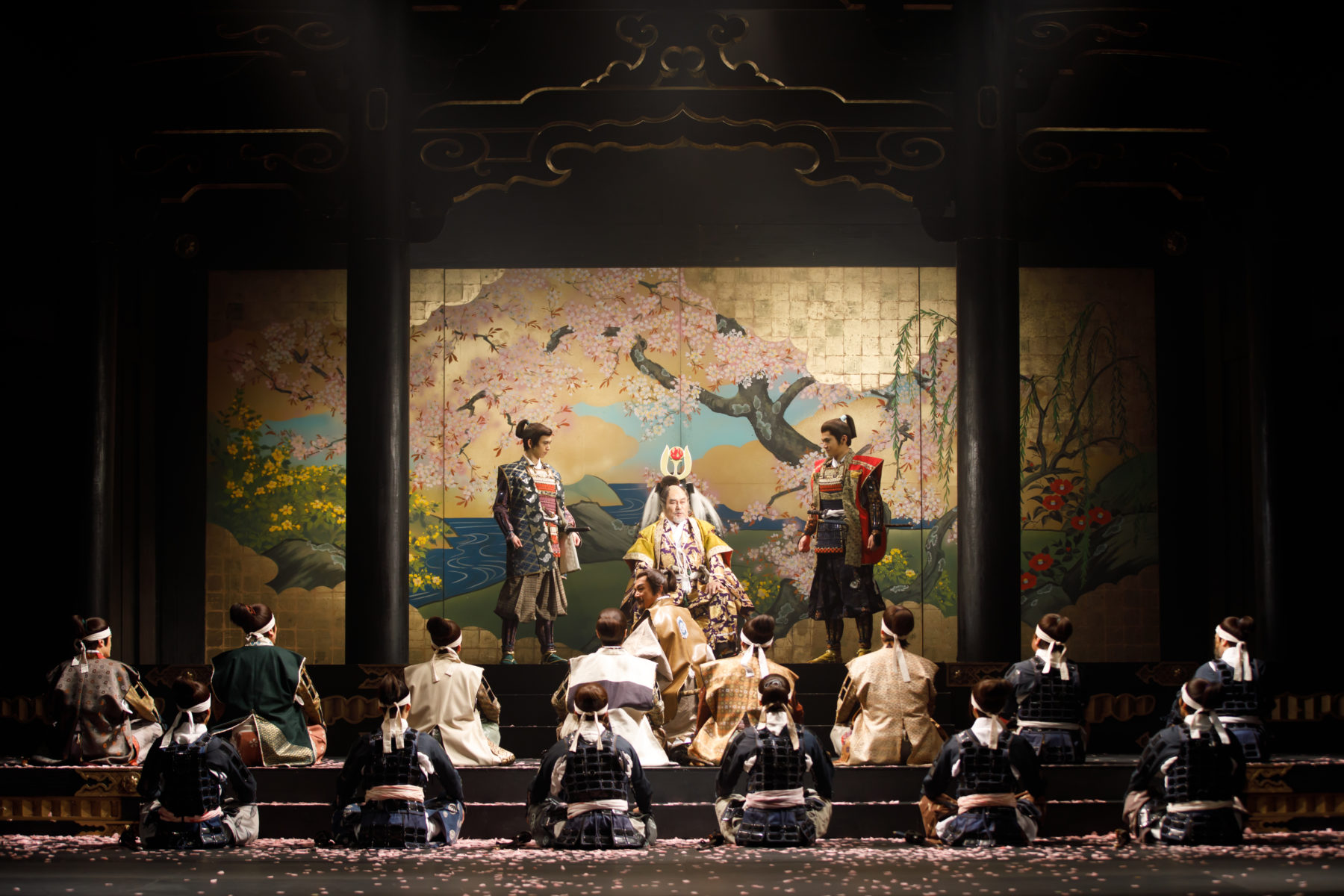By Patricia Tobin
(500 words, 5-minute read)
A dark traditional Japanese Buddhist altar, or butsudan, stands tall onstage. Engraved gold hinges line the thick borders and towering, half-folded black doors, akin to an oriental treasure chest. Upon the tolling of a bell, two old women slowly push open the butsudan doors, inviting us into the world of Ninagawa Macbeth.
Lightning strikes and three witches appear in full, kabuki-style, white-powdered makeup. The flashing light enhances the chilling, weird synchronicity of the witches’ dance. The result is breathtaking; Ninagawa Macbeth is an other-worldly beauty. The stage runs deep as small flights of stairs descend to the front. The depth of the stage allows for stunning set designs: from towering statues to striking shrines, decadent castles to stately imperial courts. The characters, too, are a part of this visual marvel. As Lady Macbeth (Yūko Tanaka) schemes, her lush pastel silk robe cascades beautifully down the stairs. Or, against the backdrop of a full red moon, a katana-wielding Macbeth (Masachika Ichimura) grimly fights off his assailants at the mouth of a giant torii gate. The highly stylised fight choreography is mesmerising: every movement is deliberate, graceful, brutal.

Ninagawa Macbeth takes place in feudal Japan and surprisingly, Shakespeare’s Macbeth fits remarkably well here. Rival kings are now powerful warlords, noble knights are dedicated samurais, hired assassins are skilled ninjas, and ghastly ghouls are red-faced, angry spirits. Most strikingly, the leap into 16th century Japan comes with a particular set of social rituals and etiquette. This rigidity results in an exceptionally composed staging, as seen in the samurai’s upright seated position in court and the servants’ reverent bows. Within this world of highly measured movements, Macbeth’s brash actions seem radically out of place. Driven by blind ambition, his bold blunders into murder and violence are in complete opposition to the disciplined samurai. The meticulous allure of Ninagawa Macbeth comes with a protagonist spiralling out of control, and it is nothing short of a spectacle. Ninagawa presents us with the ballet of the bull in a china shop, where every shattered fragment glides like cherry blossom petals.

The impeccable artistry of Ninagawa Macbeth is at times almost distracting. Shakespeare underlines the drama, but here, Ninagawa focuses on the visuals. The aesthetics are lavish and astounding, but there is a certain emotional disconnect from the unfolding drama. The characters are über-marionettes that implement Ninagawa’s bold vision of beauty, rather than focal points of a tragedy. In Lady Macbeth’s sleepwalking scene, delicate amber light falls on her solitary figure in a near dark stage. The strong tonal contrast is like a Renaissance painting, and the dramatic elements in her soliloquy are overshadowed by the magnetic allure of this visually enthralling image. While Ninagawa borrows the text of Macbeth, the intricacies of Shakespearean poetry come second place to Ninagawa’s stylistic achievements. This Macbeth is a captivating kaleidoscope; the ornate butsudan a gateway to our ancestors’ past, through which the late Ninagawa leads us in search of treasured stories.
The Singapore premiere of Ninagawa Macbeth ran from 23 to 25 November 2017 at Esplanade Theatre. This review is based on the performance on 23 November 2017 at 7.30pm.
Patricia Tobin is an arts writer from Singapore. She tweets at @havesomepatty.
This review is part of the Performance Criticism Mentorship Programme initiated by National Arts Council and organised by ArtsEquator. It is a six-month programme during which theatre critic and mentor Matthew Lyon guides mentees Isaac Lim and Patricia Tobin in reviewing one performance a month from July to December 2017.
About the author(s)
Patricia is a freelance critic from Singapore. She has been writing about theatre since 2014. She was part of ArtsEquator‘s Performance Criticism Training Program under Matthew Lyon and Lyn Gardner. She has chaired sessions at the Melbourne Writers’ Festival and at Centre 42.


